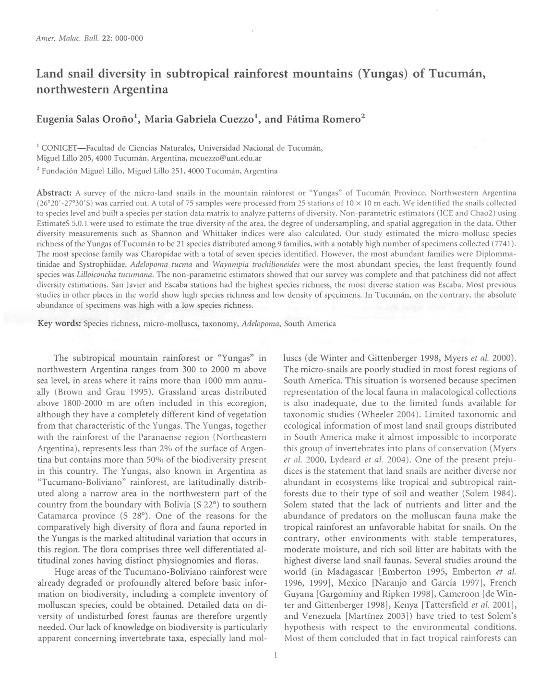Artículo
Land Snail diversity in subtropical rainforest mountains of Tucumán (Argentina)
Fecha de publicación:
12/2007
Editorial:
American Malacological Society
Revista:
American Malacological Bulletin
ISSN:
0740-2783
Idioma:
Inglés
Tipo de recurso:
Artículo publicado
Clasificación temática:
Resumen
A survey of the micro-land snails in the mountain rainforest or "Yungas" of Tucumán Province. Northwestern Argentina (26°20' -27°30'S) was carried out. A total of 75 samples were processed from 25 stations of 10 x 10 m each. We identjfied the snails collected to species leve( and built a species per station data matrix 10 anal}'Zepalterns of diversity. Non-parametric estimators (ICE and Cha02) using EstimateS 5.0.1 were used to estímate the true diversity orthe area, the degree ofundersampling. and spatial aggregation in the data. Other diversity measurements such as Shannon and Whiltaker indices were also calculated. Our study estimated the micro-mollusc species richness ofthe Yungas ofTucumán
to be 21 species distributed among 9 families. with a notably high number
of specimens collected (7741). The most speciose family was Charopidae with a total of seven specíes identified. However, the most abundant families were Diplommatinidae and Systrophiidae. Adelopoma tuema and Wayampia troc/rilioneides were the most abundant species, the least rrequently found
species wasLilloicollcha tucl/mana. The non-parametric estimatorsshowedthat our surveywascomplete and that patchinessdid not affect diversity estimations. San Javier and Escaba stations had the highest species richness. the most diverse station was Escaba. Most previous studies in other places in the world show high species richness and low density of specimens. In Tucumán. on the contrary, the absolute abundance of specimens was high with a low species richness.
Palabras clave:
Species Richness
,
Micro-Molluscs
,
Taxonomy
,
Adelopoma
Archivos asociados
Licencia
Identificadores
Colecciones
Articulos(CCT - NOA SUR)
Articulos de CTRO.CIENTIFICO TECNOL.CONICET - NOA SUR
Articulos de CTRO.CIENTIFICO TECNOL.CONICET - NOA SUR
Citación
Salas Oroño, Eugenia; Cuezzo, Maria Gabriela; Romero, Vivian de Fátima; Land Snail diversity in subtropical rainforest mountains of Tucumán (Argentina); American Malacological Society; American Malacological Bulletin; 22; 1-2; 12-2007; 17-26
Compartir




